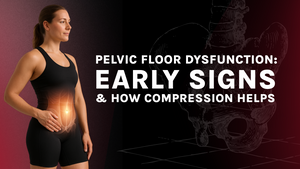Pelvic Floor Dysfunction (PFD) is a condition that affects millions of women and men worldwide, often going undiagnosed due to stigma or lack of awareness. It involves the inability to correctly contract and relax the pelvic floor muscles, leading to a range of symptoms including incontinence, pelvic pain, and prolapse. Early recognition and proactive treatment—such as physical therapy and targeted compression garments—can significantly improve quality of life.
What is Pelvic Floor Dysfunction?
The pelvic floor is a group of muscles and connective tissue that supports the bladder, bowel, and reproductive organs. These muscles are crucial for maintaining continence, supporting posture, and providing core stability. When these muscles become weak, overactive, or uncoordinated, pelvic floor dysfunction can occur (Bø & Frawley, 2010).
PFD is more common in women, particularly during and after pregnancy, but can also affect men, especially after prostate surgery or due to chronic straining.
Early Signs of Pelvic Floor Dysfunction
Recognizing the early signs of PFD is essential for timely treatment. Common symptoms include:
-
Urinary incontinence (leaking urine during exercise, sneezing, or coughing)
- Urgency or frequent urination
-
Pelvic or lower back pain
- A feeling of heaviness or bulging in the pelvic area (prolapse)
-
Pain during intercourse
-
Constipation or difficulty emptying the bowel
If left untreated, these symptoms can worsen and lead to long-term discomfort, reduced physical activity, and psychological distress (Ellerkmann et al., 2004).
Risk Factors
Several factors increase the risk of developing PFD, including:
- Pregnancy and childbirth
- Menopause
- Obesity
- High-impact sports
- Chronic coughing or straining
-
Pelvic surgery or trauma
Research shows that up to 50% of women experience some form of pelvic floor dysfunction after childbirth (Wilson et al., 2002).
How Compression Helps: Supacore Coretech® Support Shorts
In addition to pelvic floor physical therapy and lifestyle changes, medical-grade compression garments have emerged as an effective non-invasive option for managing PFD symptoms.
Benefits of Supacore’s Compression Technology:
1. Pelvic Support and Stability
Supacore's Coretech® garments feature patented body-mapped compression that supports the pelvis and lower back, mimicking the action of deep stabilizing muscles. This improves joint stability and offloads pressure from the pelvic floor (Leitner et al., 2017).
2. Improved Posture and Load Transfer
By aligning the pelvis and providing external stabilization, compression wear helps redistribute load and improve core mechanics, which may reduce symptoms like heaviness and incontinence during movement (Bø et al., 2017).
3. Enhanced Proprioception and Muscle Activation
Compression can enhance proprioceptive feedback, helping individuals engage their core and pelvic floor more effectively during rehabilitation exercises and daily tasks (Resnick et al., 2013).
4. Comfort During Exercise and Recovery
Many women avoid physical activity due to fear of leakage or discomfort. Compression garments offer security and confidence, enabling safe return to movement and improving compliance with rehabilitation programs (Hagen & Stark, 2011).
Evidence-Based Management of PFD
1. Pelvic Floor Physical Therapy
The cornerstone of treatment for most types of PFD, physical therapy involves targeted exercises, often guided by a women’s or pelvic health physiotherapist. Kegel exercises, biofeedback, and real-time ultrasound are often used to improve muscle strength and coordination (Dumoulin et al., 2018).
2. Behavioral and Lifestyle Changes
Adjustments like fluid management, bladder training, high-fiber diets, and avoiding straining can improve symptoms. Core strengthening and posture correction are also key components of a holistic approach.
3. Compression Wear Integration
Wearing compression shorts like Supacore Coretech® during rehabilitation, daily activities, or exercise offers structural support while allowing natural muscle engagement. This integration is particularly helpful for postpartum women or athletes returning to sport.
Conclusion
Pelvic floor dysfunction is more common than most people think—and more manageable when detected early. With a combination of physical therapy, healthy habits, and innovative solutions like Supacore’s Coretech® compression garments, individuals can regain control, confidence, and quality of life. If you're experiencing any symptoms of PFD, don’t wait—seek advice from a pelvic health professional and explore support tools that make recovery easier.
References
Bø, K., & Frawley, H. C. (2010). Female pelvic floor dysfunction: Prevalence, risk factors, and management. Acta Obstetricia et Gynecologica Scandinavica, 89(5), 491–494. https://doi.org/10.3109/00016341003623793
Bø, K., Sherburn, M., Allen, T., & Foster, S. (2017). Transversus abdominis activation and pelvic floor muscle function in female elite athletes. Journal of Sports Sciences, 35(16), 1663–1670. https://doi.org/10.1080/02640414.2016.1223321
Dumoulin, C., Cacciari, L. P., & Hay-Smith, E. J. C. (2018). Pelvic floor muscle training versus no treatment for urinary incontinence in women: A Cochrane systematic review. European Journal of Physical and Rehabilitation Medicine, 54(5), 745–763. https://doi.org/10.23736/S1973-9087.18.05081-4
Ellerkmann, R. M., Cundiff, G. W., Melick, C. F., Nihira, M. A., Leffler, K., & Bent, A. E. (2004). Correlation of symptoms with location and severity of pelvic organ prolapse. American Journal of Obstetrics and Gynecology, 191(3), 278–282. https://doi.org/10.1016/j.ajog.2004.01.052
Hagen, S., & Stark, D. (2011). Conservative prevention and management of pelvic organ prolapse in women. Cochrane Database of Systematic Reviews, 12, CD003882. https://doi.org/10.1002/14651858.CD003882.pub4
Leitner, M., Moser, H., Eichelberger, P., & Kremser, C. (2017). Effects of compression shorts on core stability and neuromuscular control. European Journal of Applied Physiology, 117(3), 495–503. https://doi.org/10.1007/s00421-017-3548-5
Resnick, N. M., Yalla, S. V., Laurino, E., & Zinner, N. R. (2013). The pathophysiology of urinary incontinence among institutionalized elderly persons. New England Journal of Medicine, 320(1), 1–7. https://doi.org/10.1056/NEJM198901053200101
Wilson, P. D., Herbison, P., & Glazener, C. M. A. (2002). Obstetric risk factors for urinary and faecal incontinence in women: A cohort study. BJOG: An International Journal of Obstetrics & Gynaecology, 109(9), 983–990. https://doi.org/10.1111/j.1471-0528.2002.01552.x

